Key takeaways:
- Child safeguarding principles prioritize the “best interest of the child” and emphasize the importance of involving children in the safeguarding process to empower them and foster a culture of respect.
- Effective policy dialogue among stakeholders, including parents, educators, and children, uncovers hidden challenges and opportunities, fostering empathy and understanding in shaping child safeguarding policies.
- Challenges such as divergent priorities, language barriers, and emotional weight of safeguarding issues can hinder productive policy discussions, highlighting the need for clarity and human connection in dialogues.
- The future of safeguarding policies calls for collaboration across sectors, technological integration to enhance interventions, and adaptable policies that respond to cultural shifts and youth perspectives.
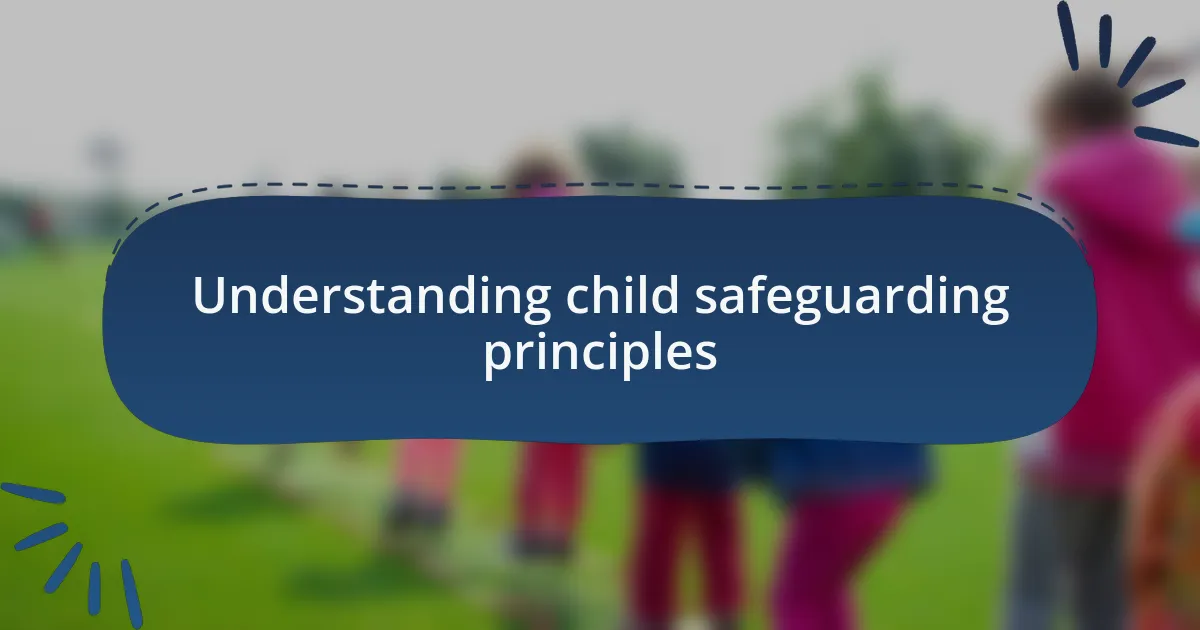
Understanding child safeguarding principles
Child safeguarding principles are essential frameworks that guide us in creating safe environments for children. From my experience, these principles go beyond mere policy; they resonate deeply with our responsibility to prioritize children’s well-being. Have you ever stopped to think about how these principles shape our everyday actions and decisions?
One core principle I often reflect on is the “best interest of the child.” This concept can be quite profound. For instance, during a community workshop I attended, a youth leader shared a case where a child was kept with family members who posed risks. Advocating for the child’s best interest meant assessing family dynamics, which can be challenging but necessary to ensure safety. It urges us to ask ourselves: are we always truly considering what is best for the child involved?
Another critical aspect is involving children in the safeguarding process. I recall volunteering at a local shelter where we actively sought children’s feedback on policies that affected them. It was eye-opening; their insights were invaluable. This experience reinforced my belief that children have a voice and deserve to be heard. How often do we genuinely include their perspectives when discussing their safety? By doing so, we empower them and create a culture of respect and trust.

Importance of effective policy dialogue
Effective policy dialogue is a cornerstone for advancing child safeguarding initiatives. In my experience, when stakeholders, including parents, educators, and children themselves, engage in open discussions, we uncover hidden challenges and opportunities. Have you noticed how collective insights often lead to more comprehensive solutions?
One particularly rewarding moment for me was during a roundtable discussion with various community leaders. We examined a new policy proposal, and I remember how one participant shared a heart-wrenching story about a child affected by inadequate safeguarding measures. Listening to them helped us recognize the emotional weight policies carry and galvanized our commitment to improving the situation. It struck me then that effective dialogue isn’t just about exchanging information; it’s about fostering empathy and understanding.
Moreover, the dialogue creates a platform where diverse perspectives collide to forge better policies. I once facilitated a workshop where participants from different backgrounds debated a policy impacting child welfare. The room filled with passionate voices and differing opinions, yet we emerged with a mutual respect and a clearer path forward. Isn’t it fascinating how engaging in constructive dialogue can transform conflict into collaboration? This kind of effective communication is essential because every voice contributes to the shared goal of safeguarding children.
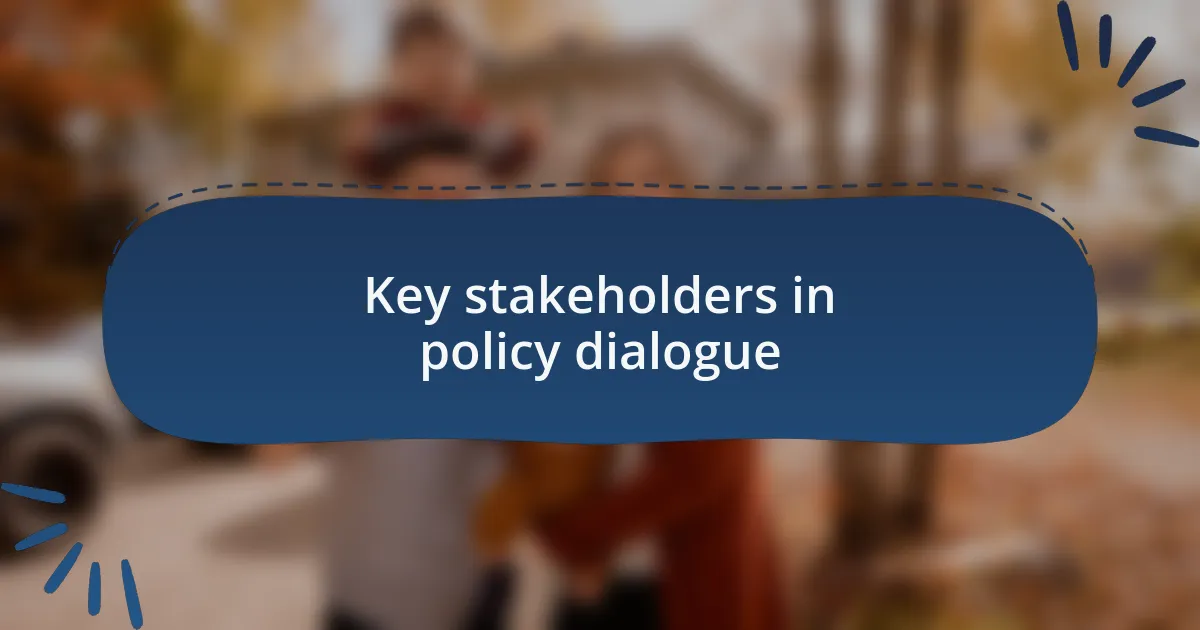
Key stakeholders in policy dialogue
Stakeholders play a pivotal role in shaping the dialogue around child safeguarding policies. For instance, when I participated in a community meeting with local law enforcement, educators, and child welfare advocates, I realized just how important these diverse voices are. Their differing perspectives fueled our discussions, revealing gaps in current practices that I hadn’t even considered before. Don’t you think that a multifaceted approach can illuminate solutions we might otherwise overlook?
It’s remarkable how various stakeholders, like healthcare professionals and social workers, provide unique insights based on their daily interactions with children. I once listened to a pediatrician share experiences about the protective role parents often overlook. This encouraged us to brainstorm ways to educate families on the signs of abuse and neglect. Moments like these remind me that every interaction holds valuable lessons that can significantly enhance policy discussions.
When parents and community members actively participate, it shifts the conversation’s dynamic entirely. In one workshop I led, a parent voiced her struggles navigating the system for her child’s needs. Her story resonated deeply, prompting immediate reactions and fostering a sense of urgency among policymakers. Can you see how personal experiences can transform abstract policies into relatable issues that demand attention?
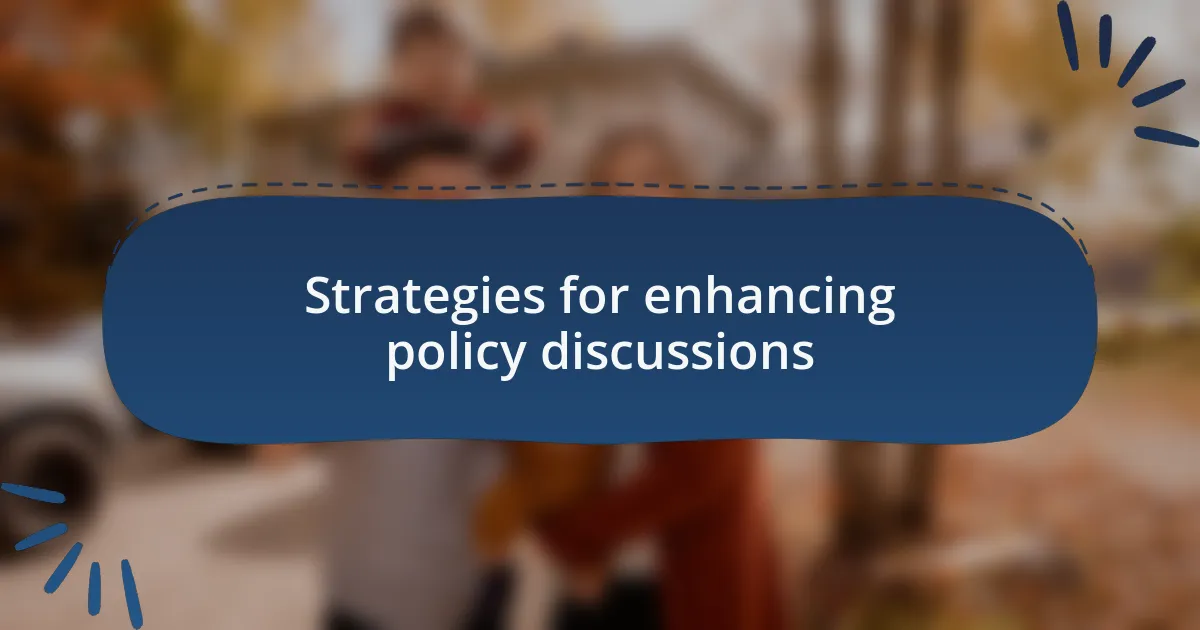
Strategies for enhancing policy discussions
One effective strategy for enhancing policy discussions is to create facilitated dialogues among stakeholders. In my experience, when a neutral facilitator guides a conversation, it helps everyone feel more comfortable sharing their viewpoints. I remember a session where we used role-playing to simulate different stakeholder perspectives. This approach not only encouraged empathy but also revealed underlying biases that needed addressing. Isn’t it fascinating how stepping into someone else’s shoes can reshape our understanding of complex issues?
Another powerful tactic is to utilize data-driven storytelling to ground discussions in real-life experiences. I once presented a case study during a meeting that highlighted how a particular policy change positively impacted a child’s life. The emotional weight of that story resonated with attendees, prompting a deeper commitment to advocacy. Have you noticed how stories can transform data into a narrative that sparks passion and action? This method turns abstract numbers into relatable experiences, making it easier for policymakers to connect with the emotional heart of safeguarding children.
Engaging youth voices in policy dialogue can also significantly enrich the discussion. I had the opportunity to attend a youth-led forum recently, and I was struck by the insightful contributions from young people who passionately shared their challenges. Their perspectives highlighted critical gaps that adults often overlook. Can we truly safeguard children if we don’t listen to their experiences? Elevating youth voices not only empowers them but ensures that our policies address their unique needs and perspectives.
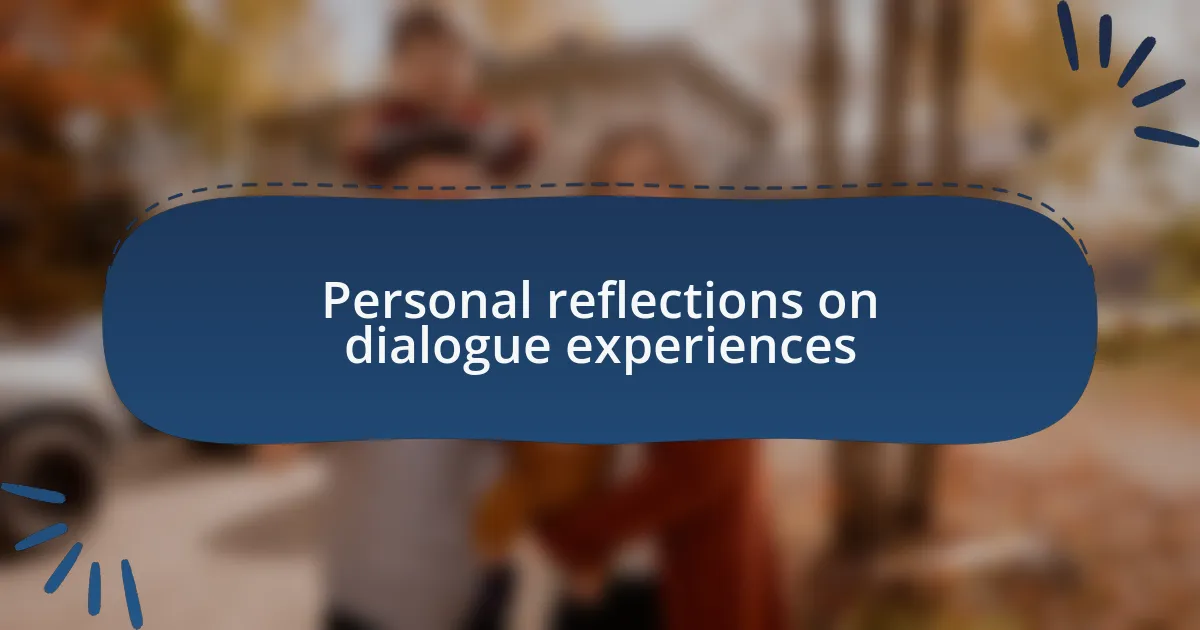
Personal reflections on dialogue experiences
In my journey, I’ve attended numerous dialogues that left a lasting impression on me. One memorable experience involved a roundtable discussion where participants were encouraged to share their emotional stories related to safeguarding. Hearing a parent articulate the fear they felt for their child’s safety opened my eyes to the real stakes of our discussions. It made me wonder, how often do we truly dive into the emotional currents that influence our policies?
Another experience that stands out involved a multi-generational panel discussion. Engaging with older stakeholders who had decades of experience was enlightening. They shared their struggles and victories in the realm of child safety, providing context that statistics alone could never convey. It made me realize how important it is to create spaces where history and fresh perspectives meet—what invaluable lessons can be learned from those who have walked this path longer than we have!
I also recall a time when I facilitated a dialogue specifically focused on the importance of trust among stakeholders. Watching the shift in energy as individuals began to share their vulnerabilities was transformative. It made me reflect on how essential it is for us to establish trust as a foundation for meaningful dialogue. Can we build effective child safeguarding policies without first addressing the human connections that underpin our work?
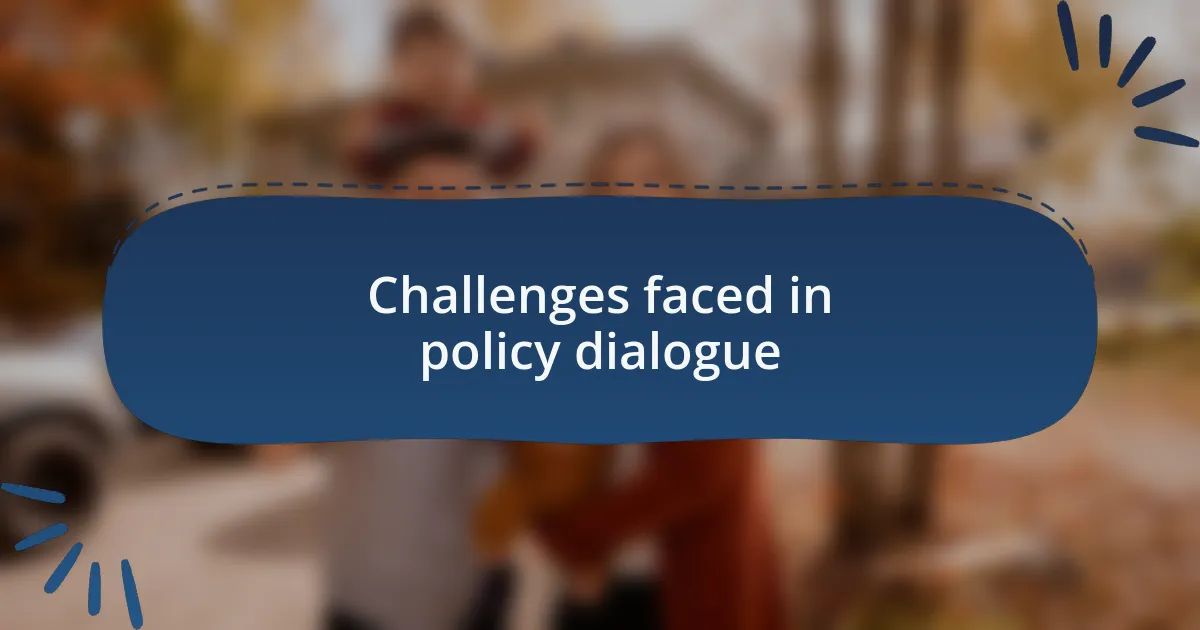
Challenges faced in policy dialogue
Navigating policy dialogue often brings to light the challenge of divergent priorities among stakeholders. I once sat in a meeting where education, healthcare, and law enforcement representatives each had conflicting views on child safeguarding measures. Listening to their debate made me question whether our passionate commitment to different causes sometimes overshadows the central focus on children’s best interests.
Another hurdle I frequently encounter is the language barrier that exists even among English speakers. Jargon specific to various fields can create misunderstandings and inhibit genuine conversation. On one occasion, during a series of workshops, I noticed how a simple term like “vulnerability” carried entirely different connotations for social workers compared to educators. This lack of a shared language underscores the necessity for clarity in our discussions—how can we make progress if we can’t agree on the terms we use?
Finally, the emotional weight of safeguarding issues can be an obstacle in policy dialogue. I remember a session that started with an outpouring of grief from survivors of abuse, which set a heavy tone for the entire discussion. While their stories were crucial, I found that the prevailing sadness dampened the spirit of collaboration. How could we channel that emotional energy into actionable policies without getting lost in despair? Balancing passion with progress is a constant struggle in this vital work.
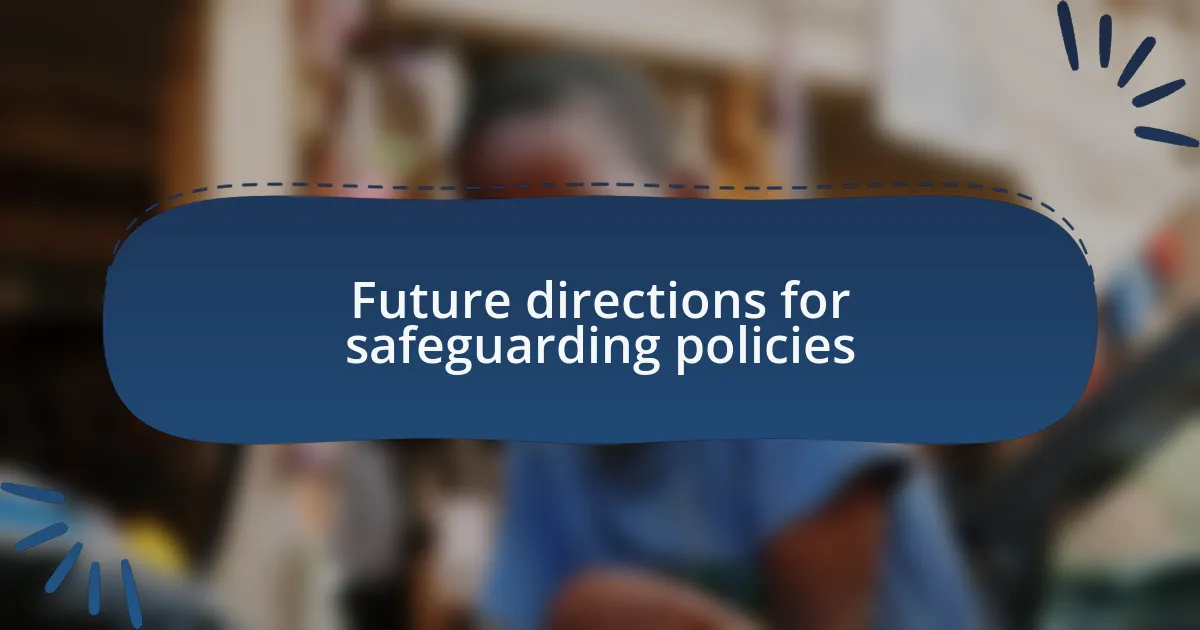
Future directions for safeguarding policies
When I think about the future of safeguarding policies, collaboration stands out as a necessity. I recall a workshop where stakeholders from various sectors came together to brainstorm. It was inspiring to see how sharing diverse perspectives led to innovative ideas, such as creating a unified framework for reporting child abuse that could be adopted across different agencies. Wouldn’t it be remarkable if we could build on this momentum and advocate for policies that embody a truly multidisciplinary approach?
Additionally, the integration of technology in safeguarding policies offers exciting potential. I have observed how data analytics can identify trends in child vulnerability, helping us target our interventions more effectively. Imagine harnessing artificial intelligence to predict where resources are most needed, allowing us to proactively protect children rather than reactively respond to crises. As we move forward, how can we ensure that technology enhances, rather than complicates, our safeguarding efforts?
Moreover, I sense a growing recognition that safeguarding policies must be adaptable and responsive to cultural shifts. Not long ago, I attended a conference where youth advocates shared their insights on how social media influences child safety. Their experiences highlighted the importance of agile policies that evolve alongside societal changes. Are we prepared to listen to young voices and incorporate their perspectives into shaping the policies that govern their lives? Embracing this dynamic approach could lead us toward more effective and inclusive safeguarding practices.